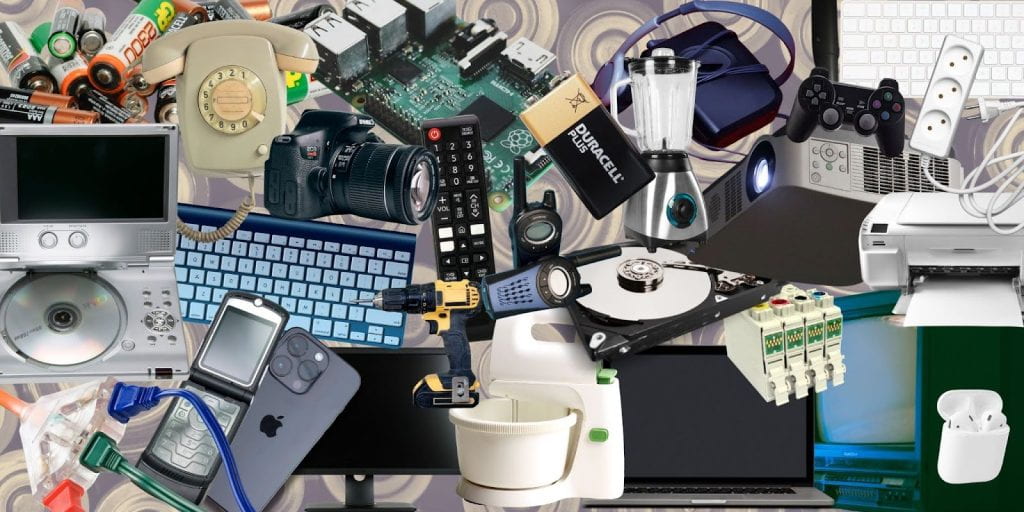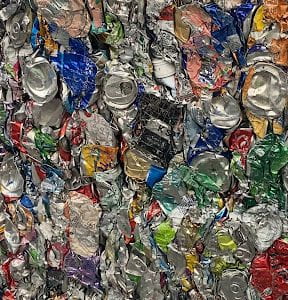Your triple A’s don’t belong in the compost… and other tips for e-waste disposal!

What are you supposed to do with dead lightbulbs? What about old phones? Even items that pop-up more frequently, like dead batteries or random electrical cords – do you know how to handle disposing of those? Most people don’t, even if they think they might. Which makes sense because electronic waste, or e-waste, is really awkward to figure out. In fact, I’m sure that my family still has our old TV from 2007 tucked away deep in our garage because we keep missing our local e-waste collections. It only makes it more challenging that e-waste disposal and recycling regulations are different depending on where you are. However, the proper handling of e-waste is so important, so I’m going to try and simplify it for you as best I can!
E-waste includes any electronic product, or product with electronic components, that has reached the end of its usable life cycle. Electronic equipment earns its distinction as a separate waste group because it’s full of harmful toxins, like lead and mercury, that can contaminate drinking water, soil, and the atmosphere, or present problematic human health issues. Therefore, it’s imperative that e-waste is kept out of our other waste streams and handled correctly. In fact, many components of e-waste, such as valuable metals, can be recycled. The U.S. Environmental Protection Agency found that “one metric ton of circuit boards can contain 40-800 times the amount of gold and 30-40 times the amount of copper mined from one metric ton of ore in the United States” (epa.org). Not only does recycling e-waste prevent harmful toxins from infiltrating the environment, it can also conserve resources and reduce extraction.
There is much work that must be done to educate the public about handling electronic waste as the infrastructure to support proper e-waste recycling is already in place. For example, “in 2016, the estimated value of recoverable materials in global e-waste was $64.6 billion, but only 20 percent of it was properly recycled to enable recovery of the valuable materials,” and everything else found its way to the landfill (Cho, 2018). The opportunity to recover valuable resources is lost when electronic waste is not properly recycled, which promotes an avoidable reliance on resource extraction – a serious problem. The first step to addressing this issue is educating people on why properly discarding e-waste is important, and the second step is to teach them how.
As stated earlier, the regulations and procedures surrounding e-waste sorting differ across the country and world. Luckily, San Francisco is home to some well-established programs for electronic waste disposal, so doing the right thing here in the City, and on USF’s campus, isn’t too hard.
Recology, San Francisco’s primary solid waste disposal partner, does not have the capacity or infrastructure to sort e-waste out of the massive amount of waste they receive. This is why San Franciscans have to take an extra step to get rid of their e-waste; however, there are still convenient and accessible options out there. For one, Recology collects electronic waste and universal waste (batteries and fluorescent or LED lights) at their SF Transfer Station and through their Bulky Item Recycling pickup program. They also offer services to businesses and property managers, but this is pretty much the extent of their e-waste sorting capacity. Other options in San Francisco include (but are not limited to):
GreenCitizen offers services ranging from pickup, drop-off, hard disk destruction, tape recycling and destruction, styrofoam recycling, and more. They have saved 22 million pounds of electronics from local landfills and global dumps, which is incredibly impressive. Visit their website for information on drop-off locations and applicable services.
San Francisco E-Waste places an emphasis on reusing or repurposing technology before recycling and replacing. They offer a plethora of disposal options and efficient pickup services.
If you ever find yourself on USF’s campus, there are plenty of locations where e-waste can be dropped off. Each residence hall hosts a collection station, either in the main lounge/lobby or laundry room, for typical consumer e-waste. You can also bring small quantities to the Office of Environmental Health and Safety located on the ground floor of Hayes-Healy or submit a Facilities request for bulk pickups or large items on campus.
It’s important to remember the role you play as an individual in waste streams and pollution. It might seem like a hassle to dispose of your dead batteries correctly, but individual actions matter, and it’s ok to make small sacrifices for the sake of the environment. Furthermore, waste isn’t waste until you waste it! Get creative with what you perceive as “waste” – it’s always fun to repurpose trash into art or to reimagine its function. You could even, let’s say, make a mosaic out of dead batteries. Anything is possible!
If you have any questions about e-waste, please consult your local waste management entity or regulatory agency. Or send us an email at sustainability@usfca.edu. Thanks for reading!
Sources
Cho, Renee. “What Can We Do About the Growing E-Waste problem?” Columbia Climate School, August 27, 2018, https://news.climate.columbia.edu/2018/08/27/growing-e-waste-problem/
“Basic Information about Electronics Stewardship.” EPA.Gov, Environmental Protection Agency, 4 Jan. 2017, 19january2017snapshot.epa.gov/smm-electronics/basic-information-about-electronics-stewardship_.html#:~:text=Also%20of%20note%20is%20the,ore%20in%20the%20United%20States.


